Cham Civil Party Describes Survival of Mass Killings
Today’s hearing at the ECCC was divided into two parts: first, the defense teams for Khieu Samphan and Nuon Chea made oral submissions regarding the Co-Prosecution’s request to summon three more witnesses. As a reaction to this, the Chamber decided not to hear any testimonies next week. The Chamber will decide on issues raised during the submissions during next week. Hearings will resume on September 28, 2015.
Second, Civil Party Him Man provided his testimony and described how he and his wife fled when the Khmer Rouge arrested all Cham people in his village. He recounted how they survived almost four months hiding from the Khmer Rouge, and how they survived after they were discovered and arrested.
Reaction to Co-Prosecution’s Request to Summon New Witness
At the beginning of the session, Trial chamber Greffier confirmed the presence of all parties with Nuon Chea following the proceedings from the holding cell. The testimony of Civil Party two-TCCP-252 would be heard.
Before the start of the Civil Party testimony, the floor was granted to Nuon Chea defense counsel Victor Koppe to make his oral submission concerning request E3/66 to call three new witnesses.
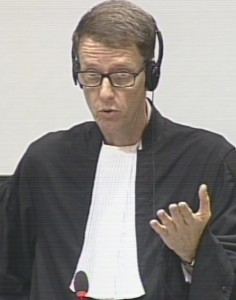
International Nuon Chea Defense Counsel Victor Koppe
Mr. Koppe explained that the international Co-Prosecution had requested to call three additional witnesses in this trial. Two of the witnesses, 2-TCW-938 and 2-TCW-894, had been requested already on 9th May. The most important witness seemed to be 2-TCW-938, who had already testified in 002/01 in early 2012. 2-TCW-938 had testified in case 004, which was placed on case file of case 004, and disclosed to the defense and other parties in February 2015. It was admitted into evidence on 17 July 2015. In August, the chamber had decided not to summon 2-TCW-938 and 2-TCW-894. The Co-Prosecution claimed that these witnesses could provide crucial evidence that the alleged mass killings of the Cham people was conducted according to a central policy and that it was therefore crucial to summon this witness. Mr. Koppe had two main points with regards to this request.
First, the earlier request to summon 2-TCW-938 had been signed by both the national and international Co-Prosecution, while this request had only been signed by International Co-Prosecutor Nicholas Koumjian. Mr. Koppe wanted to know what had changed during this time period that she did not sign the request. Moreover, he inquired whether it was legally possible under Cambodian law for the International Co-Prosecutor to request the Trial Chamber to summon a witness without the apparent consent of the national Co-Prosecution. Mr. Koppe stated that he was aware that witness Boeun had testified in the Kraing Ta Chang segment, and had been requested only by the international Co-Prosecutor. However, this had been a different situation, since she had never testified before. The difference in this case was also that Chea Leang had signed the request last time and did not do so today anymore.
Second, Mr. Koppe inquired why the Co-Prosecution had filed this request “so late”. The defense would include the Co-Prosecutor’s answer in the written submission. “We didn’t see this request coming.” More fundamentally he said that they could have known “in theory” about the existence of the evidence that is critical in the views of the Co-Prosecution. However, they had been flooded by a “tsunami of 8155 pages coming from the 500 individuals who have been given testimony in case 004” and which had been disclosed in this case. This evidence simply “had been buried.” They had not been able to read all these pages. “We do not have the time or resources to read this flood” of documents. There had been no pause between the different segments of the trial. Additionally, they are in “full preparation” of the Supreme Court hearings. Last Friday, they had filed a motion that he classified as “probably the most important” submission since 2008. Simply put, “we are pulling the emergency break. We simply cannot do it anymore.” He said that either the defense was granted more resources immediately, or the Cham hearings needed to be stopped immediately. He needed to also consult his client to receive his input about Kampong Cham, which he had been unable to do so until now.
Turning to his last point, Mr. Koppe stated that the investigators were questioning a witness at this very moment. Moreover, Aom An had been charged with genocide in case 004 in Sector 41. These investigations were therefore part of case 004
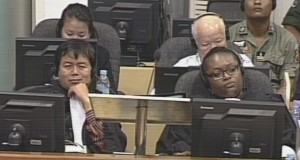
Khieu Samphan Defense Team Kong Sam Onn (l.) and Anta Guissé (r.)
.
He further stated that it was likely that exculpatory evidence would be discovered during the hearings. Mr. Koppe then explained that the situation they were facing now was different to the one at Trapeang Thma in that the defense was not disputing that Trapeang Thma had been built as part of a policy. However, the defense, was disputing that there had been a policy of genocide against Cham.
Thus, Mr. Koppe requested that there be no hearing related to the treatment of the Cham in Peam Chi Ka until the investigations against Aom An had stopped. Alternatively, he requested the Trial Chamber to hear only evidence related to the former East Zone, since that zone was not part of the investigation against Am. Moreover, they would soon request additional witnesses to be heard with regard to the treatment of Cham in the East Zone. A courtesy copy would be circulated probably upcoming Monday.
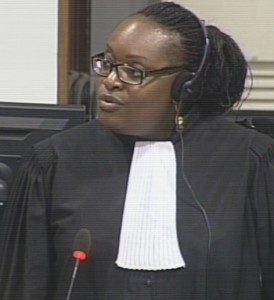
International Khieu Samphan Defense Counsel Anta Guissé
Following Mr. Koppe, Khieu Samphan Defense Counsel Ms. Guissé took the floor. She asked how the trial could be continued if there was continuously new evidence from other cases. There were “issues of principle.” This trial would come up during the entire trial if no solution would be found. Their submission E3/63 would allow the trial chamber to find a solution and proceed with the proceedings in a speedy manner. The last submission pushed Ms. Guissé to query whether the investigative work of case 002 was done properly, if this witness was “capital”.
Judge Claudia Fenz asked Mr. Koppe to clarify whether they had made a request at the office of administration to receive more resources in order to counter the lack of time and/or resources. He replied that he had done so “numerous times”, but that there were no resources available. “It’s impossible.” Judge Fenz then inquired how much more time the defense team would need to prepare properly. Mr. Koppe replied that this was difficult to estimate. He had not been able to read most of the 8,000 pages properly. In contrast to the Co-Prosecutors, who shared the days in court, “I’m being in court every single day”. He estimated that he might need a few weeks, but was unable to give an exact number of days.
Demand for Clarifications
Judge Jean-Marc Lavergne asked to clarify what 8,000 pages Mr. Koppe was referring to, and that it should be born in mind that these had been disclosed several months ago. Mr. Koppe replied that he did not have enough time to read these in detail, since “I only have 24 hours a day, maybe you have more” Judge Lavergne asked again how Mr. Koppe could not have made himself with the pages. “I’m absolutely stunned.” Mr. Koppe replied that he did not have the time to read all these pages in a coherent way. In response to this, Ms. Guissé stated: “I feel extremely ill at ease in the manner” in which “something that was under the supervision of the Co-Prosecution is suddenly under the supervision of the defense”. Investigations first needed to be concluded. That this was not done while testimonies on the treatment of Cham were heard was “a serious procedural issue.” She further stated that she was at unease if they had to justify each time why they had not been able to do something. She further alleged that there “the impression is given that we, the Khieu Samphan team, have to justify ourselves that we need so much time”
Reactions by the Co-Prosecution
Senior Assistant Dale Lysak took the floor. His first point was that the oral submission Mr. Koppe had made today sounded more like a response to the filing than a separate submission. Being able to file a response afterwards gave them the opportunity to respond twice, which Mr. Lysak criticized. Moreover, the Nuon Chea defense team could have sent an e-mail to all parties to notify them of the requests they would make today. If they wanted to “put a question to the national co-prosecutor, who is not here today”, they should have asked before.
Second, Mr. Lysak rejected the argument that they had been late to request the witnesses. They had made a request for two of the witnesses in filing of May 2014. The third one was a new witness that “we have discovered”. The May 2014 witness list included these two witnesses. Since then, investigations have been ongoing and “commune chief and district chiefs have testified about the existence of orders from above to identify and kill all Cham.” Counsel should have been aware of this evidence.
The Prosecution had been made available five of the interviews of the district chief in December 2014. Once they had been made available, the Prosecution had made an immediate request to disclose the statements and admit them into evidence. A separate filing had been made for just the five interviews of this witness. Thus, “everybody knows who this witness is and the importance of her.”
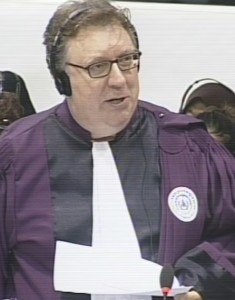
Senior Assistant Prosecutor Dale Lysak
With regards to the argument by the defense teams that new evidence of case 004 should not be used, Mr. Lysak stated that there had been requests to admit new evidence in the Appeal Hearings. Moreover, parties had used documents made available form case 004 in the Trapeang Thma segment, including the Khieu Samphan Defense Team.
According to Mr. Lysak, this new evidence would “put an end” to the academic discussion whether there had been a policy to kill Cham people. District chiefs provided clear evidence that there was a policy to identify and kill Cham in their areas.
As regards the procedure of ongoing investigation running parallel to the current hearings, Mr. Lysak stated that the disputed area in Kampong Cham, despite being particularly important, did not differ procedurally from other areas that related to charges in case 002 and 004. There would be ongoing investigations, disclosures, and disclosure evidence would be continued to be heard. There was no reason to postpone the Cham segment until the end of the investigations. He stressed that “there should be no surprise at all about the witnesses.”
Next, he queried that after the Khieu Samphan team had been using this kind of evidence “all of a sudden it becomes a matter of principle that we must not hear any of this evidence anymore?” He alleged that “at some point a few weeks ago”, when the Defense Team was preparing for the Cham segment, of these key interviews and critical evidence “that is obviously damaging to the defense.” According to Mr. Lysak, this court had an obligation to ascertain the truth. Both Prosecution and Defense had the right to submit new evidence when they meet criteria, which these witnesses do.
Reactions by Civil Party Lead Co-Lawyers
Civil Party Lead Co-Lawyer Marie Guiraud stated that they were in the same situation as defense with access to documents. She agreed with Mr. Koppe, stating that “we did not anticipate that motion”. She also did not realize the importance of 2-TCW-938, seeing the magnitude of the work that each of the parties have to do. “We can therefore understand that the defense is asking for more time. […] Reading, digesting and understanding information that is disclosed” was time consuming. However, it was in the interest of Civil Parties for the trial to make process. She said that “we have never objected to a request to summon a witness”, and always relied on wisdom of Chamber to decide this. They would rely on this for this matter as well.
She clarified that to her recollection, Ta An had not been charged with genocide, but crimes against humanity and persecution in this area instead. The Trial Chamber should consider “whether Ta An should be asked to summon” to explain what happened in the area in question. There were no procedural obstacles to this, and he had cooperated with court before.
Mr. Koppe stated that he was pleased by support of the Civil Party Lead Co-Lawyers and to hear that they also did not expect this request.
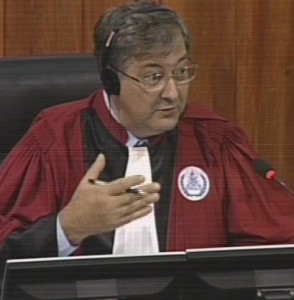
Judge Jean-Marc Lavergne
Judge Lavergne asked for clarification regarding the question why only the International Co-Prosecutor had signed the request. Were they challenging the validity of this request? Mr. Koppe replied that the National Co-Prosecutor should be the one calling a witness.
When International Co-Prosecutor Nicholas Koumjian stood up, the President intervened. He stated that
The President stated that “I think the Chamber is rather confused now. It seems the parties take turn to be like a host on TV broadcast or radio broadcast.” Each side should submit their observations, before it was the turn of the other party.
The National Deputy Co-Prosecutor stated that the matters raised by the Defense team were a response to the Co-Prosecution’s submission. Thus, he was in no position to represent the National Co-Prosecutor. She could do so in writing.
Civil Party Testimony: Him Man
After the break, the President announced that the Chamber decided that the testimony of the Civil Party would be heard today, since the Civil Party was in the compound of the ECCC already. The decision would be issued “perhaps next week”.
Civil Party Him Man was born in 1949 in Sach Sau Village, Peam Chi Kan District, Kampong Cham Province. He currently lives there and is father of five children.
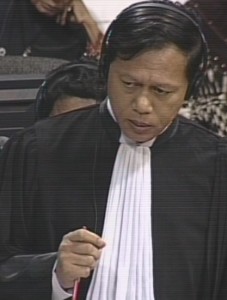
Civil Party Co-Lawyer Lor Chunthy
Civil Party Co-Lawyer Lor Chunthy from Legal Aid of Cambodia started his line of questioning. He started his by asking general questions about Mr. Man’s background. Mr. Man lived in Sach Sau Village before 1975. No Khmer people lived with the Cham people in this village. There were mosques. The Cham people practiced their religion without restrictions before the arrival of the Khmer Rouge. After 17th April 1975, he continued living in Sach Sau village. Later, the Cham people were transferred elsewhere. Half of the villages were evacuated and dispersed. He estimated that there were around 200 or 300 Cham families in this village, but since he was not in charge of the statistics, he was not sure. The person in charge of this was Ta Kim. After an evacuation, he did not see “half of the villagers” anymore. They were on foot during their evacuation. There was no vehicle to be used for their transportation. He estimated that this happened in 1975 and took place during the dry season of that year. He knew one of the evacuees, namely Ta Soekrit Sos. After the evacuation, 30 families remained in the village. Many Cham families had been transferred before. His family was amongst the 30 families and continued living there.
They were invited to attend a meeting, where they were told that “we, the Cham ethnicity” were required to cut their hair, stop practicing their religion, and required to eat pork. According to Mr. Man, they had been told that “the wheel of the history was moving and if we happened to put our hands in or put our legs in to stop the wheel, our limbs would be cut by the speed of the wheel.”
During the time, the village chief was Tam. He was Cham. Ta Tam was appointed to be the village chief and he told him about the restrictions. He received instructions from the upper level. He was taken away and killed later. Mr. Man was working while the meeting was conducted nearby. Asked by Mr. Chunthy how he knew that Tam received the instructions from the upper echelon, Mr. Man replied that in the Khmer Rouge regime, when a village chief disseminated such information, it was certain that he received the instruction from the upper echelon. However, he did not know which level this information stemmed from.
After this meeting, people started to disappear, either individually or with the whole family. This happened continuously. “People kept disappearing.” Further, they were taken away “at gunpoint”. The procedure depended on how many people the Khmer Rouge took away. Sometimes two or three were taken away at meal time. At every mealtime, they were afraid that they would be taken away and killed. He presumed that the arrestees were taken to Wat Au Trakuon.
Arrests of Cham People
Asked about the reasons for the arrests of the Cham, Mr. Man stated that they secretly prayed to Allah despite the monitoring. However, they did not tell them the reason why the Cham were arrested. They assumed that they were monitored, and if someone was caught praying, that person would be taken away and killed.
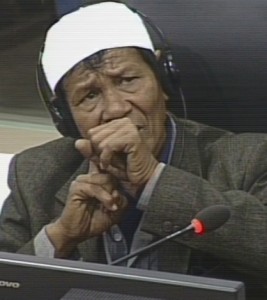
Civil Party Him Man
Mr. Chunthy inquired whether they ate communally and whether they were forced to eat something. Mr. Man replied that Cham people were forced to eat pork after the meeting. When they had their meal, no one inspected whether they ate pork. “Everyone was afraid.” They were afraid that the person next to them would report to Angkar. Thus, no Khmer Rouge was present at the meal time. Some believed that if they were forced “at gunpoint”, they could eat pork in order to survive. With
this believe, some people ate pork. While doing this, “some people were weeping.” He himself had to eat pork. “Otherwise I would be shot dead.”
Mr. Koppe interjected and requested the lawyer to be more specific with regards to time periods.
Mr. Chunthy inquired about the year that the events the Civil Party had described. Mr. Man answered that he estimated it took place in around 1976.
Mr. Chunthy turned back to the meeting that the Civil Party had mentioned. He asked whether it had been mentioned during that meeting that the Cham were considered the enemy. Mr. Man replied that there was a rumor in the village that the “Cham were enemy Number 1” while “Khmer People were Enemy Number 2″. He asked a Khmer person why Cham were considered “Enemy Number 1”. This person had answered that this was because the Cham “were greedy” in engaging in the battles in wars due to their belief. Subsequently, Cham people were arrested.
Mr. Chunthy then asked whether other people were sent to live in the village after the Cham had been transferred. Mr. Man confirmed this and said that the Khmer Rouge relocated Khmer people to “mingle with the Cham people.” Hence, there was no distinction between Cham people and Khmer people. He estimated that this event took place in 1976.
Mr. Chunthy inquired about the day that the Cham people were “rounded up and taken away from the village.” Mr. Kong Sam Onn interjected and asked for reference, which Mr. Chunthy provided.[1] Mr. Sam Onn then stated that a general question should be asked before referring to a document.
Escaping from the Arrest
Mr. Chunthy rephrased his question and asked whether “he knew about an event that took place in your village subsequently.” Mr. Man replied that subsequently the Cham were not allowed to work in the fields, while the Khmer people were allowed to work in the field. The remaining Cham people after the evacuation were instructed to stay home. “They started rounding us up at 3 pm in the afternoon.” The people who collected the Cham people were members of the long Sword unit. “They were shirtless and had long shorts”. The Civil Party himself was amongst the people who were taken to the pits. He discussed with his wife how they were going to survive. In the group of arrested people, he was walking in front of the people so that the Khmer Rouge was thinking that “I was heading to the pits.” He met a person who asked him where he was going to. He told him that he was searching for his cattle. He called his wife to come along, because “they had to rush to find the cattle”. He was moving ahead with his wife. At that time, he met another person. The other Cham people had been gathered by the members of the Long Sword group.
However, they were unable to leave the village yet, since there were armed people at the edge of the village. Thus, they were hiding in the bushes around 15 meters away. He could clearly see the armed people: they were carrying AK 47 rifles.
During the arrests there were two groups. First, the Long Sword group who was “herding the Cham.” Second, another armed group was guarding the group at the outskirt of the village.
They gathered together the Cham people in by instructing Khmer people to work, while the Cham people were instructed to stay at home. When these Cham people were arrested, Cham people would be tied if they resisted. Those who did not resist were not tied. The situation was rather chaotic. “The dogs were barking and the chickens were running here and there.”
He tricked the Khmer Rouge and made sure when they saw him, he would not resist instruction. Later, he could hide himself in the bush. He remained there until it became dark around 7 pm. The place where he was hiding was around 100 meters away from the pits where they were killed. He was lying in the bush with his wife. They heard people screaming and people being hit and asking Allah for help. No other people but the Cham people would pray to Allah.
At this point, the President adjourned the hearing for a break.
After the Escape
After the break, the President informed the parties and the public that after Civil Party lawyers and the Co-Prosecution have of this Civil Party’s testimony, the Chamber would adjourn its hearing today. The chamber will not sit next week. Judge Fenz stated that the chamber would deliberate on the remaining issues that were raised this morning.
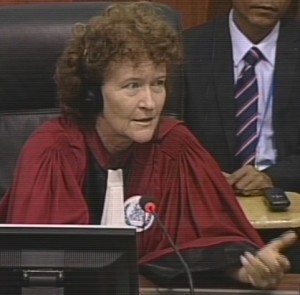
Judge Claudia Fenz
The floor was then granted to Lor Chunthy again. He asked how long the Civil Party was hiding in the bushes and what he did during this time. Mr. Man replied that he “was planning to hide in the pond.” Since he was afraid of being caught, he decided to hide in the bushes with his wife. He heard the screaming around 6 pm or 7 pm: “Oh my Allah, please help me!” He could not find any weapons to help himself. He went to see villagers in his own village, with whom he used to eat together.
He could not help anyone, because he “could not find a single weapon.” His physical strength decreased. Some of his neighbors had gone. Thus, “I had no hope”.
He went westwards to Ta Cheap’s house. He went into many houses to see whether any Cham were left. He did not find anyone. He started weeping. “Only my wife and I were still living at the time.” He went there around 4 am.
He came back to see his wife and discuss where to go. They moved into a pond and stayed in that pond. The day after, in the morning, “they fired M-79, B-40, AK-rifles […] at me in the pond.” His wife and he were not hit by the bullets, but he could feel the vibrations. He decided to stay under the water, since he would have been killed otherwise. He was staying “under the water” for around eight days. “I was so hungry at the time.” He clarified that he was “running around” for eight days. The roots of the water-hyacinths were eaten by the rats close to the pond banks. He ate snails, toads, frogs and other insects. When he relieved himself, “there was not smell”, because he only ate vegetables and insects. There were snakes everywhere in the water. In the morning, he would cover himself with the trenches to hide. At the lake, he was hiding in the water-hyacinths. “It was a terrible situation, Mr. Lawyer.”
One time, the water was rising and flooded the village. At this time, he left the water. One day, he found two unripe papayas. “It was so delicious!”, he said, since he hadn’t had food for 3 months and 29 days. He knew this exact number of days, because he counted the days “from time to time.” He remembered: “It was like a year hiding in that place, when we spent only one day in the pond or in the bushes.” Thus, his wife and he started counting the days.
Mr. Chunthy stated that he had gone into the village to look for weapons and that his older sibling had been arrested. Mr. Man replied that his name was Ahmad Kamel, His mother Lap Ly was also arrested. Amina, Thuo Ny, Ibrahim, Kahva, and other neighbors and distant relatives had all been arrested.
Mr. Chunthy then inquired whether Mr. Man knew the names of militiamen in his area. One militiaman who was part of the Long Sword unit was called Yung and Chop. He also remembered the name Doeun, but did not know where he was living at the moment.
Civil Party Lead Co-Lawyer Marie Guiraud asked whether she properly understood the testimony that he hid in the lake for 3 month and 29 days and counted these. Mr. Man confirmed this. He survived by eating eels, insects, vegetables, snails and fish. “I ate everything at the time like a rat.” If there had been no vegetables or no other food, he would have died.
Ms. Guiraud then inquired about the occasion when the Cham were brought to the pits. She asked how far the pits were from the lake where he was hiding. He stated that the distance between the pond and the field was around 200 meters. Sometimes he could smell the stench. If the dead bodied were floating in the river and he could have reached them, “he may have eaten those dead bodies, because of hunger.” He could smell the stench from the pitch where his mother died. “I had a long breath to smell the stench so that I could know what the stench was.” He said that “I am here to testify before the chamber. I am not a novelist. I am not here to create a story. So the stench at that time, I could say, was a good smell for me, because of hunger.”
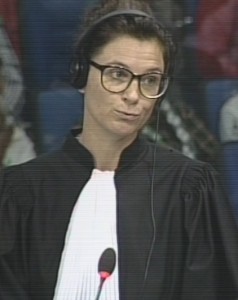
Civil Party Lead Co-Lawyer Marie Guiraud
When Ms. Guiraud asked why he left the lake and where he went, he said that after he left the pond, he was going to “any place that would be safe for me. Actually I was planning to go to Vietnam.” When he left the water, he was caught he was caught and beaten by members of the Long Sword unit. They were living at the upper part of the corn barn. He was detained and was about to be sent to be killed at Wat O Trakuon. “I had a strange feeling at the time.” In fact, “my chest was pounding.” He further recounted that “I was about to kick a pig nearby.” Somehow, the people living nearby begged the Khmer Rouge to spare his life. Kan decided to spare their life. “Kan spared me, because I knew how to untangle the net at the bottom of the river.” He was skillful at blacksmithing. Ms. Guiraud inquired whether this lake was in his native village Sach Sau, which the witness confirmed. He was sent to Sambuor Meas. He was detained in an old corn barn. It was a temporary place to detain people before they were sent to be killed.
After having left the corn barn, he stated that he was allowed to live next to the corn barn.
He was given food to eat. People warned him not to eat too much, since he would be killed otherwise. He only dared eating small amounts of food. This situation lasted for around two to three months. Afterwards, he heard that people talked about two Cham people who survived. However, the Khmer people did not hate him. The people named him Lim and his wife Nah.
There was a rumor that another Cham was killed and that he was put on a boat. Later, there was a rumor that he was amongst a group of children who were taken to Sambuor Meas to be killed. However, he said that when he was sent on that journey, the boat machine was broken. The Khmer Rouge asked him whether he could fix it. He saw that the ventilator was broken. He was checking the machine, when everything “became chaotic” when the Vietnamese attacked. The Khmer Rouge were fleeing. Thus, the people on the boat who were to be killed survived. He said that he thought all Khmer people in his area would be killed “in the end.” He saw a “reserve pit”, which was around 50 meters by 50 meters. He said that the pits were meant for the Khmer people, since there were no Cham people anymore. He described the Vietnamese as “saviors.”
He apologized for telling this story, but stated that it made him feel better.
Ms. Guiraud then inquired about the incident on the boat and asked whether he had been told why he was arrested a second time. He replied that his “life was dependent on the Khmer villagers.” He believed that his life was spared because of his expertise in untangling the net and repairing machines. When being put on the boat, he was meant to be killed with these people. “Still, they used me to navigate the boat.” Since he had heard that there were people who were killed, he only pretended to fix the machine. “Luckily we all survived because of our saviors. Without them, we would be all dead.”
Ms. Guiraud then inquired whether he saw some of the Cham inhabitants of Sach Sau after the end of Democratic Kampuchea again. He answered that they separated everyone. Some survived including Ta Somkrit Sok, whose family also survived. Ta Kym also survived the regime. Not everyone returned. He only saw the family of Ta Sok who returned to the village.
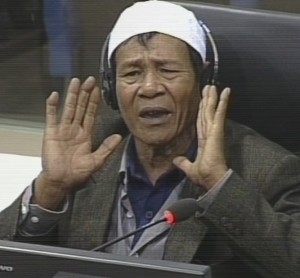
Civil Party Him Man
Ms. Guiraud then asked whether he had seen the pits in 1979 following the arrival of the Vietnamese. He replied that they were located in the area where the Cham lived. Currently, there is a mango plantation. The pits were around 50 meters by 50 meters.
Ms. Guiraud then asked whether there were two type of pits. She asked about the pits where the Cham were led to and inquired whether he saw these pits again. He said that he did not see the pits where the Cham bodies were buried at the Au Trakuon Pagoda during the Khmer Rouge regime. After the Khmer Rouge regime, an organization had asked him to measure the pits situated at Au Trakuon pagoda. The area was now a mango tree. The pit that he saw was empty. “It was in anticipation of the subsequent killing.”
Ms. Guiraud referred to his statement.[2] He had stated that there were many bones and some clothes, but no flesh. Ms. Guiraud asked whether he remembered this episode. He replied that he had testified to the best of his knowledge. “I know that my parents were killed there. That was the area that they were killed. I even heard their screams.” In his view, it was impossible for people not have been killed there. People went there and dug for gold there.
Targeting the Cham
At this point, Senior Assistant Prosecutor Vincent de Wilde took the floor. He asked whether he used the Cham language to communicate with other Cham people before the Khmer Rouge arrived, and whether he spoke Khmer. The Civil Party stated that “all Cham people spoke the Cham language”. They only spoke very rarely Khmer. They would have an accent when speaking Khmer. They practiced their religion before the arrival of the Khmer Rouge. Cham people could be distinguished from Khmer people by the way they dressed.
During the evacuation, the majority of Cham people were sent to the “upper part of the area” to live amongst the local residents. He did not know the motive behind the relocation. He did not know about their fate, but he heard that they were placed in various villages.
Mr. de Wilde inquired whether the religious leaders, such as hakims, returned. Mr. Man stated that Kom Youssuf and his family returned, but he did not see anyone else again.
The mosques were used to store rice. A grinder was placed in there. He did not see them burning any Qur’an. However, they were explicitly prohibited from praying, wearing traditional hair, or carry any Qur’an.
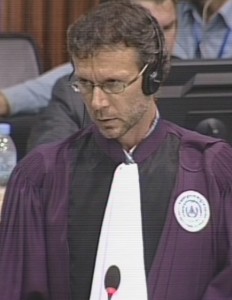
Senior Assistant Prosecutor Vincent de Wilde
Mr. de Wilde then referred to Ysa Osman’s interview.[3] Mr. Man had stated that the Khmer Rouge intended to kill the Cham by letting them die of hunger or of illness. The Khmer Rouge wanted to suppress the Cham, since they saw that if they were united, “what happened in Koh Phal would happen again.” Mr. de Wilde inquired what made the Civil Party say that the Khmer Rouge wanted to make the Cham die of hunger or illness. Mr. Man replied that this was presumption based on his experience. His relatives had been taken away. Mr. de Wilde then wanted to know whether he heard about this rebellion at that time or after the end of the Khmer Rouge regime. Mr. Man replied that he heard about it at the time. From that time onwards, the situation for Cham became worse. Cham people had been taken away and killed, because Cham people insisted on practiced their religion.
Mr. de Wilde read out an excerpt of Mr. Man’s Civil Party Application.[4] He had said that the Khmer Rouge would broadcast information that there would be no longer any Cham and Khmer, but only Khmer as one nation. He asked whether Mr. Man heard this announcement often.
The Civil Party replied that they “wanted us to be the Khmer nation. (…) They wanted to eliminate all Cham.” Mr. de Wilde asked whether Mr. Man had ever heard the announcement that the Cham nations had to be eliminated. Mr. Man replied that the village chief had not made this announcement very often. There were these announcements, but not very often.
Mr. de Wilde inquired whether he knew that Wat O Trakuon was used as a Security Center before the end of the regime. Mr. Man replied that he heard this before. People were shackled, people were detained. The distance between his house and the pagoda was around 100 meters. He did not measure it, however, so this was only an estimate. Mr. de Wilde then inquired whether he noticed a nauseating stench around the pagoda. Mr. Man replied that since he was hiding in the pond, he could smell it. Mr. de Wilde clarified that he was referring to the time before the Civil Party was hiding in the lake. He replied that “no one was living in Sach Sau village.” They were all killed.
Mr. de Wilde then asked whether he saw Khmer Rouge cadres from the Southwest Zone arriving in his region. Mr. Man replied that he did not see who the high level people and superiors were. “They all had dark complexion.” He was assigned to dig canals and carry soil.
Mr. de Wilde inquired where Kan came from and whether he had an accent that was different from those from the North Zone. Mr. Man replied that he was not from his village. “I head of the name Kan. I heard him say ‘let Ta Man survive’” He did not know where Kan was from.
Mr. de Wilde turned to the day when they were gathered and taken to Wat O Trakuon and asked how many people were gathered. Mr. Man replied that more than 20 or 30 families were arrested, including him. All of these had been taken away. He assumed that these people had died.
This prompted Mr. de Wilde to read out an excerpt of Mr. Man’s interview with Ysa Osman.[5] In this interview, Mr. Man had stated that hundreds of villagers had been assembled and came from different villages in his district. Mr. Man said that “all of them died”, because they were all sent to work at the worksite. The total number would reach hundreds or even thousands. There were only few Cham people evacuated from his family. There were only a few Cham families remaining in his village after the evacuation. He believed that other people would be taken in groups and sent elsewhere.
Mr. de Wilde then asked whether music was being played while Mr. Man heard screaming. Mr. Man replied that he heard screaming and crying, calling for Allah to help. He hid close to the pagoda. He believed it was coming from the loudspeakers, but he was sure that it were human beings who were screaming.
Mr. de Wilde then inquired whether he knew that many people were aware of the fact that he and his wife survived. Mr. Man confirmed this and said that 50 % of them “know that I and my wife survived the regime.”
Mr. de Wilde then asked whether he knew someone called Tay Kimhuon from the Long Sword unit, which the Civil Party denied. He could only recall the two names he mentioned earlier.
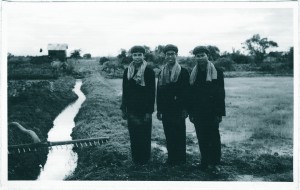
Khmer Rouge Leaders in the field (Documentation Center of Cambodia Archives)
Mr. de Wilde then quoted Tay Kimhuon who said that two Cham survived.[6]
Mr. de Wilde asked whether he knew someone called Seng Srun. Mr. de Wilde stated that he read out what Seng Srun had said. The Civil Party replied that he does know Seng Srun, who lives in Sambuor Meas Village A. Mr. de Wilde read out an excerpt of Seng Srun’s statement.[7] Mr. Srun had said that 300 Cham were arrested in August 1977, and that towards the end of 1978, “the two Cham who had managed to escape were found. They were arrested but were not executed.” Mr. de Wilde asked whether this was an accurate timing. Mr. Man stated that he did not know when exactly Cham people were arrested, but that he would agree to what Mr. Srun had said. “I know this person very well.”
Mr. de Wilde then inquired whether Mr. Man agreed to the assertion that 300 people were arrested, which Mr. Man confirmed. “Perhaps Srun is more accurate with his figure”, since he did not have the number of the people who were arrested.
Mr. de Wilde asked how he lived with the memories of his experience on a daily basis in the commune, being the only Cham with his wife who survived. “How were you able to come to terms with that?”
The president adjourned the hearing. Hearings will resume on September 28 2015, at 9 am.
[1] E3/4706, at 00369051 (KH), 00407868 (EN), no French translation. [2] E3/5203, at 00321726 (FR), 002892091 (EN), the English ERN in the English translation was only given: 2092 (KH) [3] Ysa Osman, the Cham Rebellion, E3/9938, at 00286655-56 (FR, unclear in the English translation), 00218503 (Eng), 00218496 (KH). [4] E3/4706, at 00417861 (EN), 00369050 (KH), 00898349 (FR) [5] E3/9938, at 00218497 (KH), 00286656 (FR), 00218503 (EN). [6] E3/5257, at 00251021 (EN), 00342673 (FR), 00243107-08 (KH). [7] E3/5302, at 00623191 (FR), 00635176 (KH) 00210488 (EN).
Featured Image: Witness Him Man (ECCC Flickr)

[…] recounted that a Cham person called Him Man and his wife fled when the Cham villagers were rounded up and brought to Wat O Trakuon to be […]